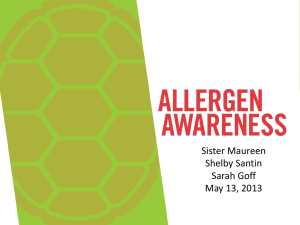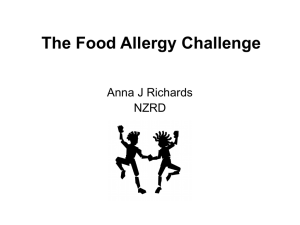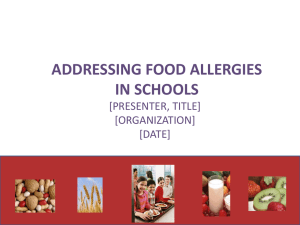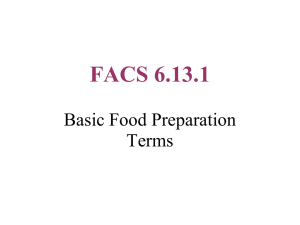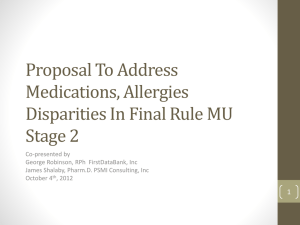Module 6. - Food Allergy Education
advertisement
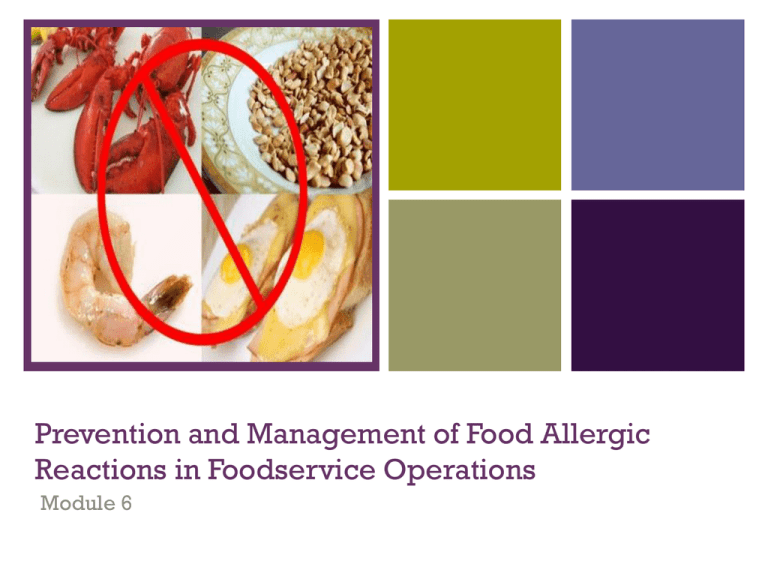
+ Prevention and Management of Food Allergic Reactions in Foodservice Operations Module 6 Module Content + Food allergy management plans in foodservice establishments Challenges and issues specific to foodservice operations Strategies to reduce/eliminate food allergy risks Best practices + Food allergy management plans in foodservice establishments Table 6.1. Recommended Food Allergen Control and Management Plan. General 1) Establish/maintain a group of advisory board members who can provide advice to the foodservice operators. 2) Determine common types of food allergens used in specific foodservice operations. 3) Develop an allergen control plan through food production and service systems as a part of the food safety program. Segregation of allergenic food or ingredients during storage, handling, and processing 1) Store allergenic ingredients or products separately to prevent cross-contact with other food items. 2) Have a separate kitchen area for the production of allergen-free foods. 3) Develop standard operation procedures (SOP) for the production of allergenfree foods. Supplier control programs for ingredients and labels 1) Require food suppliers to notify changes of food ingredients. 2) Locate detailed ingredient information from commonly used manufacturers and a person(s) to contact when questions arise. 3) Review food ingredient lists regularly and update SOP for the production of allergen-free foods. + Food allergy management plans in foodservice establishments Table 6.1. Recommended Food Allergen Control and Management Plan. Prevention of cross-contact during processing 1) Set aside dedicated processing equipment, tools, containers, utensils, and work areas to prevent allergen cross-contacts. 2) Clearly mark allergen-free tools, containers, and utensils (e.g., color-code them), and store them away from other equipment and utensils used for general production and service. 3) Minimize the reuse of processing and/or cooking media (water or oil). 4) Restrict personnel working on processing lines containing allergenic ingredients from working on allergen-free production lines. Training 1) Provide general training on allergen awareness and control for all employees in your foodservice establishment. 2) Train staff how to check the ingredients of menu items to see if they contain allergens. a. Have a list of the ingredients of each menu item. b. If ingredients cannot be changed in menu items or are unavailable, staff should inform the guest that they cannot provide safe food for them. 3) Provide training to all new staff on food allergies before they interact with customers to create better awareness and understanding. + Food allergy management plans in foodservice establishments Serving consumers with food allergies Know who will answer guests’ questions about food allergies. Advise customers with allergies not to eat certain foods. Establish steps to avoid crosscontact. Have at least one person available during hours of operation who can handle questions and special requests. If a guest says that he or she has an allergy, direct the designated person to handle the order. Fried foods should be avoided, as the cooking oil may be used for many foods unless there is a designated fryer. Desserts should be avoided, as many desserts incorporate the main food allergens, such as nuts. Fresh fruit may be a good alternative. Sauces should be avoided, as these may include unexpected ingredients. Buffet and cafeteria services should be avoided, as there is a high possibility of cross-contact due to dishes being close together and guests serving themselves. Have scheduled times throughout the day for a staff member to check the kitchen and preparation areas for proper cleanliness and organization. + Food allergy management plans in foodservice establishments The emergency plan should include the following (FARE, 2010): Call 911 immediately for emergency medical attention. Locate management; have a list of individuals to call if the immediate supervisor cannot be reached. Keep the individual from standing up. Comfort the guest and keep others calm. Do not leave the scene until the emergency medical crew arrives. If an epinephrine auto-injector (e.g., an Epipen®) is available, make sure it is stored in a designated area so that it can be easily found. Teach employees how to administer epinephrine auto-injector, if applicable. + Challenges and issues specific to foodservice operations Staff members rely on customers to inform them about specific accommodations due to food allergies Untrained or inadequately trained staff members are not reliable for informing customers about food ingredients (Kronenberg, 2012) Food labeling for major allergens is not a requirement for restaurants (Taylor & Baumert, 2010) Recipes can be modified to use unintuitive or creative ingredients, such as peanuts in pizza sauce (Taylor & Baumert, 2010) Space and equipment available for food preparation is limited (Taylor & Baumert, 2010) + Challenges and issues specific to foodservice operations Many other avenues for cross-contact exist: Fish, shellfish, and gluten can become airborne during cooking processes (FARE, 2010) Shared cooking surfaces and cooking oils in fryers (Taylor & Baumert, 2010) The sharing of cooking and serving utensils can be habitual in some operations (Taylor & Baumert, 2010) Serving methods, such as the use of the same tray to serve both allergen-containing items and allergen-free items, salad bar cross-contact that occurs due to customer actions, and plates overlapping when the server carries dishes to the table, can result in cross-contact (Taylor & Baumert, 2010) + Strategies to reduce/eliminate food allergy risks Implement cross-contact prevention. Set up the kitchen with food allergens kept away from commonly used items. Thoroughly clean and sanitize work areas before preparing allergen-free orders. Wash hands and change gloves before handling allergen-free orders. Use separate grills and cutting surfaces for allergen-free orders. + Strategies to reduce/eliminate food allergy risks Ensure ingredient disclosure. Follow recipes strictly. Do not allow other ingredients to be added to the food. Keep the most current ingredient listings for all food items so that they are readily available for viewing. Train staff on menu ingredients and how to read labels to determine the presence or absence of allergens. Verify ingredients periodically for pre-made and convenience products. Make common allergen information available to staff. + Strategies to reduce/eliminate food allergy risks Foster communication Communicate with your customers about their food allergies. Encourage your customers to carry a Chef Card (FARE, 2013) and give it to the chef, who will prepare allergen-free foods. A Chef Card outlines the foods that your customer needs to avoid due to their food allergies. See an example of a Chef Card at http://www.foodallergy.org/document.doc?id=219. Introduce the ingredients of the dish and how it is prepared to customers with food allergies + Strategies to reduce/eliminate food allergy risks Foster communication Communicate effectively (The Culinary Institute of America, 2008) When a guest requests an allergen-free meal, all employees who may be involved in preparation of the guest’s food and service to the guest need to be alerted immediately. When communicating with the guest, the staff should do the following: Be honest Look the guest in the eye Say “I understand” to communicate attentive listening Repeat the important points back to the customer to clearly demonstrate understanding Ask, “Is there anything else we can do?” Offer to have the guest meet the manager Communicate the allergy information to other staff members in plain language that everyone can understand + Strategies to reduce/eliminate food allergy risks Establish standard operating procedures for allergen-free meal preparation. When the chef is notified about an allergen-free meal request, he or she should visit the customer’s table to make sure the specific needs are clearly communicated. If the chef is unable to provide an allergen-free meal or is unsure of his or her ability to do so, the customer should be informed and provided other options. Implement a comprehensive food allergy risk plan (Kronenberg, 2012). A well-established plan reduces liability challenges in case of an emergency and may increase the customer base. + Strategies to reduce/eliminate food allergy risks Train employees to manage the risks. Some states require food allergy safety training for employees. The Massachusetts Department of Public Health enacted the Food Allergy Awareness Act (FARE 2014). Restaurants are required to do the following: Display a FARE food allergy awareness poster in an area visible to staff Include the following notice on menus and menu boards: “Before placing your order, please inform your server if a person in your party has a food allergy” Have a manager who has undergone training through a certified vendor of the Massachusetts Department of Health (FARE, 2014) Rhode Island has enacted a law similar to that of Massachusetts (FARE, 2014). The city councils of New York, New York and St. Paul, Minnesota have already approved a proposal requiring restaurants to present food allergy awareness posters (FARE, 2014). New Jersey provides posters that remind staff that allergen-free requests should be taken seriously, to check product labels, and to avoid crosscontacts (Kronenberg, 2012). + Strategies to reduce/eliminate food allergy risks Train employees to manage the risks. Staff should be aware of the possible modes of cross-contact specific to their operation’s environment (The Culinary Institute of America, 2008). A plan and specific practices should be developed for handling food for a customer with a food allergy (The Culinary Institute of America, 2008). At all business hours, an employee who understands food allergies well should be scheduled (Wachs et al., 2012). + Strategies to reduce/eliminate food allergy risks Management strategies for potential food allergy reactions. Follow the Four Rs when dealing with a customer with food allergies (FARE, 2013): Refer the food allergy concern to the manager, chef, or person in charge Review the food allergy with the guest and check ingredients on labels Remember to check the preparation procedure for potential cross-contact Respond to the guest and discuss your findings with him or her + System for Handling Food Allergies (The Culinary Institute of America, 2008) 1. Customer says “I’m allergic to a food.” 2. Service staff notifies manager. 3. Manager talks with diner about his or her special needs. 4. Manager consults with chef. 5. Chef checks ingredients. 6. Chef communicates the need for added precautions to kitchen staff. 7. Kitchen staff or chef prepares meal. 8. Manager, server, or chef carries the plate separately to the table. 9. Server confirms that the dish has been specifically prepared to accommodate the diner’s food allergies. 10. Server checks with the diner immediately to make sure the meal is satisfactory. + Best practices Programs that are appreciated by individuals with food allergies and their families. In schools: Provide peanut-free schools or tables, or implement nonfood-sharing policies Provide training to food handlers regarding food labels and provide training to principals, nurses, and teachers on epinephrine administration Communicate with parents of children with food allergies about special accommodations and possible concerns + Best practices In restaurants: Provide online menu and ingredient information Communicate with consumers about their food allergies and which food items to avoid Provide specific allergen-free dishes Provide food allergy training to both front- and back-of-house employees + Summary Restaurants and other foodservice establishments are recommended to establish a “Food Allergen Control and Management Plan”, and an “emergency plan” to serve consumers with food allergies. Prevention strategies and plans in place by restaurateurs should focus on: Identification of hidden food allergens Cross-contact prevention Effect communication Employee food allergy training and risk management plans

